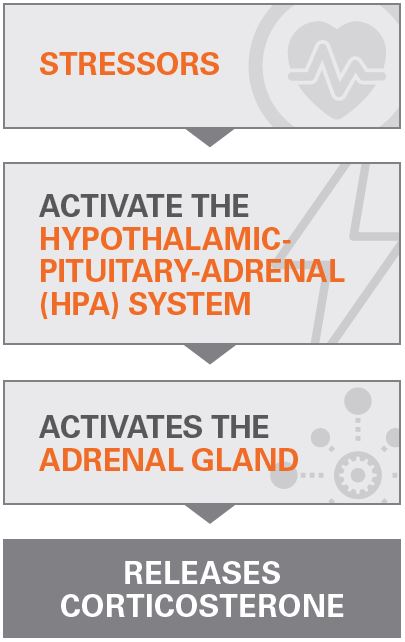Animal efficiency is a metric that all livestock and poultry production systems monitor and tightly regulate because it has a dramatic impact on a system’s profitability. How animal efficiency is evaluated – or costs attributed to it – is dependent on various factors, whether it be feed, animal health or management protocols. One such factor is livability.
You are viewing United States
- United States
- Canada
- Mexico
- South America
- EMENA
- Sub-Saharan Africa
- Russia
- South Asia
- Asia Pacific
- China
A global presence, with local expertise. Visit our regional sites:
- United States
- Canada
- Mexico
Popular Searches
- Animal Nutrition & Health
- KemTRACE® Chromium
- KemTRACE® Chromium for Broilers
- KemTRACE® Chromium Resources for Broilers
- Exploring the Impact of Stress on Livability
Exploring the Impact of Stress on Livability
In poultry integration, pullet and broiler livability can have a huge impact on how an integrator manages the number of pullets placed or number of eggs set, respectively, in order to meet the needs of their customers (e.g. pounds of meat out of the plant). Pullet livability can have an impact on the overall cost of production, in that if disease or management is not able to maintain livability, producers would take on additional costs, such as buying eggs or replacing pullets that have been lost. The same can be said for broiler livability, whether it be early or late mortality, with the latter being more costly due to the addition of feed cost. Ultimately, additional eggs would also need to be set in order to compensate for the decrease in broiler livability and still fulfill customer orders.
The high level of production efficiency today is the result of improved feeding, management and breeding practices. Several investigations have been made to determine the importance of different factors in broiler production.1 It has been concluded that broiler weight and broiler feed conversion are the most important factors determining net income.2 However, high livability is pre-requisite to favorable returns because feed conversion is closely correlated with mortality and cost per pound of broiler.1

The health and performance of birds, as well as livability, can be influenced by environmental, metabolic and social stressors that the flock experiences. Mortality in a load of finished birds is considered to be influenced by the following three main factors: health status of the flock, thermal stress and physical injury during catching and loading.3
When an animal first encounters a stressor, the neurogenic system is activated.5 Failed attempts to combat or flee from the stressor immediately result in the activation of the hypothalamic-pituitary-adrenal cortical system.5 The activation of this system eventually leads to the proliferation of the adrenal-cortical tissue, which then secretes corticosteroids (i.e. stress hormones).6 Previous studies have shown that corticosteroids have a negative impact on broiler growth and performance.7 Chromium has been shown to reduce the levels of corticosteroids in birds alleviating the negative impact of stress on them.8,9 Furthermore, chromium has been shown to improve livability in birds subjected to different type of stressors.9
Ultimately, if we can lower the corticosterone levels in stressed birds, we can help them grow more efficiently and be better prepared to face disease and stress challenges to maintain high livability. Learn more about stress and the only FDA-reviewed source of chromium propionate on the market today at kemin.com/stress.
References
1Strain J.H. Nordskog A.W. The Relative Importance of Breeder Flock and Broiler Flock Factors Determining Income Over Feed Costs in Random Sample Broiler Tests. Poult Sci. Volume 41, Issue 5, 1 September 1962a, Pages 1573-1577.
2Strain J.H. Nordskog A.W. Genetic Aspects of the Profit Equation in a Broiler Enterprise. Poult Sci., Volume 41, Issue 6, 1 November 1962b, Pages 1892-1902
3Bayliss, P.A., and Hinton, M.H. 1990. Transportation of broilers with special reference to mortality rates. Appl. Anim. Behav. Sci. 28: 93–118.
4Chauvin, C., Hillion, S., Balaine, L., Michel, V., Peraste, J., Petetin, I., Lupo, C., and Le Bouquin, S. 2011. Factors associated with mortality of broilers during transport to slaughterhouse. Animal, 5: 287–293.
5Siegel, H. S. (1980). Physiological stress in birds. Bioscience 30:529–533.
6Holmes, W. N., and J. G. Phillips (1976). The adrenal cortex of birds. Pages 292–420 in General, Comparative and Clinical Endocrinology of the Adrenal Cortex. I. Chester Jones and I. W. Henderson, ed. Academic Press, New York, NY.
7Dupont J., M. Derouet, J. Simon and M. Taouis (1999). Corticosterone alters insulin signaling in chicken muscle and liver at different steps. Journal of Endocrinology 162, 67-76
8Mirfendereski and Jahanian, 2015.
9Lester T., Brown K., Vignale K., Alvarado C., Lee J., 2018. Evaluation of chromium propionate and a butyric acid complex on male growth performance, corticosterone level and meat yield. International Poultry Scientific Forum. Atlanta, Georgia. Abstract M86, pg. 26.
Have a Question?
If you have a question about our products or services, or just want more information, fill out the form below and someone on our team will be in contact with you.
Products
Careers
Careers
- California Residents
- California Supply Chain Act
- Email Disclaimer
- GDPR Personal Data Addendum
- General Terms & Conditions for Vendors
- Global Environmental Policy Statement
- Indirect Cost Estimates
- Kemin Terms & Conditions
- Modern Slavery Act Transparency Statement
- Privacy Policy
- Sitemap
© Kemin Industries, Inc. and its group of companies All rights reserved. ® ™ Trademarks of Kemin Industries, Inc., USA
Certain statements may not be applicable in all geographical regions. Product labeling and associated claims may differ based upon government requirements.
You are viewing United States
- United States
- Canada
- Mexico
- South America
- EMENA
- Sub-Saharan Africa
- Russia
- South Asia
- Asia Pacific
- China
A global presence, with local expertise. Visit our regional sites:
- United States
- Canada
- Mexico
Privacy Policy
By browsing this site you permit us and our partners to place identification cookies on your browser and agree to our use of cookies for marketing. Review our cookies policy for details.

